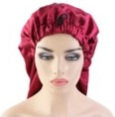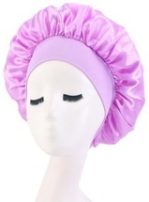

Her Hair Bonnet Description
A hair bonnet (cap) is a head covering used to protect hair when sleeping and other occasions.
When sleeping, the bonnet helps to prevent hair damage caused by sleeping on the hair (Books, 2020).
More specifically, the hair bonnet provides the following benefits:
1. Minimizes Frizz and Hair Loss
Wearing a bonnet can prevent or reduce friction while you sleep at night. The amount of frizz you wake up with is, therefore, reduced. Frizz means misalignment of hair/s.
Your hair might be frizzy owing to not only friction, but also drying out.
Excessive hair frizzing results to breakage and split ends, resulting to hair loss in the long run (Collins, 2021; Penrose, 2021).
Protecting your hair with Her Hair Bonnet from Canagoza diminishes stress and assists to prevent split ends (Collins, 2021; Penrose, 2021).
2. Less Dryness
Dry hair is a root cause of hair problems. Sheets and pillowcases can soak in moisture from our hair, causing dryness. Significant amount of moisture prevents itchy scalp, frizz, split ends, and hair loss.
Her Hair Bonnet helps to retain moisture (Books, 2020; Collins, 2021).
3. Decreases Tangling
Tossing and turning at night can cause your hair to get easily tangled. For finer straight hair, gently brush the hair out to get rid of any knots. Next, twist the hair at the top of your head. Finally, cover your hair with Her Hair Bonnet (Collins, 2021).
If you have curlier, kinky texture hair, do not brush it. Instead, softly tuck it in your Her Hair Bonnet.
Using Her Hair Bonnet will help prevent new tangles from forming. It, therefore, becomes less stressful managing your hair in the morning (Collins, 2021).
4. Helps Maintain Your Hairstyle Intact
Investing money on a good hairstyle only for it to unravel as you sleep is very disappointing. Investing in a good hair bonnet will assist you to maintain your good hairstyles for longer timeframes.
Apparently, wearing Her Hair Bonnet reduces friction as you toss and turn in your sleep and other occasions, helping to maintain your hairstyle intact (Books, 2020; Collins, 2021).
5. Helps with Do-it-yourself Hair Care
When performing do-it-yourself hair case, Her Hair Bonnet is a great friend. The bonnet assists to preserve heat for your pre-poo to be successful (Books, 2020). Pre-pooing is a process of applying a hair treatment before performing the actual shampoo process (Higuera, 2019).
Her Hair Bonnet maintains your hair rollers intact, allowing you to unravel your lively shiny curls in the morning. A hair roller is a small tube you roll in your hair to curl the hair or make straight curly hair, thereby creating a new hairstyle (Books, 2020).
Her Hair Bonnet thus supports/protects your do-it-yourself styles to prevent experiencing unfavorable hair days (Books, 2020).
6. Helps Prevent Face from Breakout
Sometimes your hair collects different pathogens in the air while you go about your day. You might be recommended to not wash your hair every day to avoid removing its natural protective oils.
Sleeping in Her Hair Bonnet can prevent the pathogens from moving to your pillowcase and sheets to cause face breakout.
Her Hair Bonnet protects from hair products/residues/treatments that can itch and cause breakouts (Books, 2020).
7. Keeps Your Sheets and Pillowcases Clean
Hair products might get messy and greasy at times or frequently. Her Hair Bonnet protects your sheet and pillowcase from absorbing hair products/residues/treatments.
Such hair products include oils, conditioner, shampoo, dye, and other hair products (Books, 2020).
8. Used as Hair Restraints by Food Handlers
When working with food, it is important to keep a food handler, food, and consumer safe (New Mexico State University, n.d.). Every food handler is, therefore, required to wear in an effective way a hair restraint covering all exposed body hair.
Food handlers include persons working at food factories, chefs (cooks), and among others.
Examples of the hair restraints include hair bonnets, beard bonnets, and headbands (Government of the District of Columbia, Department of Health, 2016; U.S. Food & Drug Administration, 2022).
Hair restraints, like Her Hair Bonnet and His Beard Bonnet from Canagoza, helps prevent hair from getting into food. The hair can carry bacteria onto food. The food will thus become unsellable and even dangerous to the consumer.
Ordinary, consumers who discover hair in food are disgusted. These consumers are less likely to purchase the contaminated food.
Notably, His Beard Bonnet is worn by men to help cover face hair, including beards, moustaches, as well as goatees (StateFoodSafety Resources, 2022).
Hair restraints prevent shedding hair from falling into/contacting clean and sanitized equipment, utensils, linens, and among other items (New Mexico State University, n.d.; StateFoodSafety Resources, 2022).
Hair restraints help to prevent loose hair (hair hanging freely) from getting caught in any machinery. If caught, the outcome can be serious injury or even death (New Mexico State University, n.d.).
Moreover, hair restraints help to prevent the food handler from touching their hair and consequently contaminating their hands (Government of the District of Columbia, Department of Health, 2016; StateFoodSafety Resources, 2022).
Please be sure to tie all of your head hair back when using Her Hair Bonnet. Simultaneously, the hair bonnets and beard bonnets for the food handlers must be clean (New Mexico State University, n.d.).
Undoubtedly, sizing is important in everything we wear, and bonnets are no exception. With that being said, please do not wear a hair bonnet which is too tight.
Engineering Materials Used to Manufacture Her Hair Bonnets
Her Hair Bonnet is made from either of the following engineering materials:
1. Silk
Silk is a natural fiber that provides a smooth and soft feel. Silk is strong yet lightweight, naturally shiny, and breathable. Typified by low static cling, silk also drapes well. Silk fabric naturally regulates temperature. It is typified by low heat conduction. Due to the low heat conduction, silk remains cool in hot weather and warm in cool weather (Sissons, 2021).
The natural, smooth texture of silk enhances hair quality. Her Hair Bonnet made from silk fabric maintains natural oils in your hair. The bonnet helps to maintain the hair safe from sleep friction and tension, especially between your hair and other surfaces. Silk prevents frizziness and decreases tangles and thinning (minor to moderate hair loss). Silk helps to lock-in moisture, which can help in preventing formation of split ends (Books, 2020; Cherney, 2019; Denton-Hurst, 2021; Mamona, 2021).
Silk bonnets can prevent dry hair. The reason is that cotton and other pillows absorb moisture from hair, causing dryness. Using a Her Hair Bonnet made from silk fabric will diminish this moisture loss. Silk also leaves your hair feeling soft. All in all, silk serves as a good material for every type of hair, particularly dry hair vulnerable to breakage (Books, 2020; Cherney, 2019; Denton-Hurst, 2021; Mamona, 2021).
2. Polyester Satin
Polyester satin is technically a type of weave instead of a type of fabric. Usually, the polyester satin is soft and shiny fabric on one side, a side commonly linked to satin term. Polyester satin drapes well, provides gentle feel, is non-abrasive, and is less expensive than silk (Hasin, 2021).
Similar to a silk bonnet, a satin bonnet helps to keep the hair safe from sleep friction, maintains natural oils in your hair, and helps in locking in moisture (Books, 2020). If you have curly or wavy hair, sleep might cause a serious mess. Sleeping on satin bonnet helps maintain the curls’ shape and style without creating kinks and bumps. The satin bonnet helps prevent hair from becoming frizzy and poofy. Poofy hair occurs when curl clumps are separated (Evert, 2020).
The attractively shiny material of the polyester satin bonnets looks good on everybody. The elasticity around the bonnet enables it to stretch to fit your hair. Polyester satin hair bonnets come in various colors and prints. You can choose an adorable color/print matching your pajama (Magadla, 2020).
Photos Credit: Canagoza
Polyester Satin Bonnets


3. Cashmere
Cashmere bonnets are made from the fleece of Kashmir (cashmere) goats. As a type of natural wool, cashmere fiber comes from the soft undercoat (underdown) of the Kashmir goats. Cashmere fabric is extremely soft, silky, and luxurious. It is also very drapeable. Your fingertips will feel a pleasant and gratifying sensation once you run your hand/s down fine cashmere (Fabric Link, 2021).
With a silky texture, cashmere is not itchy. The secret lies in the shape of cashmere fibers. Cashmere fibers are bumpy, not straight. The bumpy fibers have a tendency to cling to one another. Nothing, therefore, sticks out to irritate you. Straight fibers are highly likely to stick out (Feldman, 2017).
Cashmere keeps you warm. You, however, do not feel hot in it. Cashmere fabric is lightweight. Its fibers do not go beyond 18.5 microns (micron is a unit of length equal to one millionth of a meter) (Cambridge Dictionary, 2021a; Feldman, 2017).
Cashmere is significantly durable. High quality cashmere lasts significantly long if it is correctly taken care of (CCMI, 2017).
Cashmere clothing is expensive. One major reason is due to time and labor intensive production techniques and manufacturing. A second reason why cashmere is expensive is due to its scarcity. Each Kashmir goat is only able to produce 4-6 ounces (113.4-170.1 grams) of underdown per year (Ariel, 2021; Feldman, 2017).
Cashmere comes in different colors. The colors include white, orange, brown, grey, and among other colors.
Cleaning of Her Hair Bonnet
You must always wash your Her Hair Bonnet regularly to decrease product buildup (particularly if you use several oil-based hair products). The chemicals and oils in the products will stain fabric, and capable of having a negative impact on the elastic headband (“4 wash tips for bonnet & scarf care,” 2019; Ifaas, 2021).
Experts recommend you should wash your hair bonnet at least once per week if you use many products, and if it is significantly covered with the products.
If your bonnet is not covered with the hair products and you wear it every night, you should aim to wash it at least once per two weeks.
If you experience a serious hair issue that involves an allergic reaction, wash your bonnet frequently (“4 wash tips for bonnet & scarf care,” 2019; Ifaas, 2021).
In addition, knowing how to care for your Her Hair Bonnet is important in keeping it for a long timeframe. Generally, give your bonnet a wash using a mild (gentle) detergent formulated for sensitive skin in order to prevent occurrence of forehead breakouts or rashes from heavily scented soaps (“4 wash tips for bonnet & scarf care,” 2019).
Do not use hot water, as it can damage/shrink the fabric (Ifaas, 2021).
1. Silk
When it comes to washing silk bonnet/s, there are some rules you should keep in mind in order to protect the bonnet. Whether you aim to wash by hand or in a machine, it is crucial to keep the following in mind:
a. Use a detergent for delicates. Silk is apparently a fragile material. Silk should only, therefore, be washed with a mild (gentle) detergent (designed to take care of silk) and cool water.
b. Never ever wash with chlorine bleach. Chlorine bleach has a high potential to damage fibers.
c. Aim not to dry your silk bonnet in direct sunlight. Exposing it to sunlight for a long timeframe might cause color/s fading or damaging of silk.
d. Never tumble dry. Silk is very delicate. High temperatures of the tumble dryer might shrink or damage your silk bonnet (Ifaas, 2021; Tide, 2020).
Hand-washing
The safest way to wash silk bonnets is to hand-wash them. Follow the step-by-step instructions below:
Step 1: Add cool/lukewarm water in a basin
Add cool/lukewarm water in a basin or sink. Submerge the bonnet.
Step 2: Add detergent for delicates
Add a few drops of a mild (gentle) liquid detergent or some mild (gentle) powder detergent for delicates. Use your hands to stir the added detergent.
Step 3: Soak the bonnet
Leave the bonnet to soak for three minutes.
Step 4: Stir the bonnet
Use your hands and move the bonnet up and down gently to remove dirt.
Step 5: Rinse in cool water
Rinse the bonnet in cool water until all detergent is washed out.
Step 6: Absorb surplus water using a towel
Utilize a microfiber towel from Canagoza to absorb the moisture. Do not rub or wring out (twist).
Step 7: Hang the bonnet to dry
Place the bonnet on a hanger or a drying rack. Allow it to air-dry (aim not to dry in direct sunlight).
Machine Washing
Step 1: Sort the laundry
Do not wash silk and other delicate fabric alongside heavy pieces of garments, for example, jeans.
Step 2: Place silk bonnet in a mesh bag
Using a delicates wash bag will shield your silk bonnet and other silk clothing from any abrasive damage. Please note: Wash only your bonnet with other silk garments that are not typified by color fastness.
Step 3: Load the machine
Ensure to leave an adequate gap to fit in a hand. Doing that will ensure you do not overload the washing machine.
Step 4: Add the mild (gentle) detergent
Follow the dosing (correct amount to be added) instructions on the package (container) of the detergent.
Step 5: Begin a delicate cycle
Your washing machine should have a delicate wash option. It should be a cool delicate cycle. You should set the wash temperature to not more than 30 degrees Celsius. Choose also the shortest spin cycle.
Step 6: Use a towel to absorb water after the wash
Remove the silk bonnet from the machine. Use a microfiber towel from Canagoza to absorb surplus moisture. Do not wring or twist.
Step 7: Hang the silk bonnet or lay flat to dry
Aim not to dry your bonnet in direct sunlight (Persil, 2021; Tide, 2020).
2. Polyester Satin
Hand-washing
You will need:
a. A basin/sink/tub
b. Cool water
c. Mild (gentle) detergent
Step 1: Make Cleaning Solution
Add some cool water in a basin/sink/tub. Add a small amount of mild (gentle) detergent. Make sure the detergent is uniformly distributed in the water.
Step 2: Soak the Bonnet
Before soaking, ensure to put it inside-out. Soak the bonnet in the cleaning solution for roughly 5-10 minutes.
Step 3: Gently Rub
Gently rub the polyester satin bonnet in the cleaning solution in order to do away with the stains.
Step 4: Rinse
Empty the basin/sink/tub sink with the dirty water. Add clean water. Rinse the bonnet until all detergent is washed out.
Step 5: Air-dry
Take out the bonnet. Do not squeeze to avoid the probability of disfiguring the bonnet. You may place the bonnet on a clean microfiber towel from Canagoza to take out excess water. Always air-dry the Her Hair Bonnet within a well-ventilated area (Ifaas, 2021).
Machine Washing
Step 1
Place the polyester satin/s into the washing machine.
Step 2
Set the water level based on the size of the bonnet.
Step 3
Turn the water temperature dial to warm. Hot water is capable of harming polyester satin.
Step 4
Set the dial to gentle/delicate.
Step 5
Turn on the washing machine. Add mild (gentle) detergent. Follow the dosing (correct amount to be added) instructions on the package (container) of the detergent.
Step 6
Remove the polyester satin once the cycle is complete. This prevents formation of wrinkles on the polyester satin bonnet.
Step 7
Dry the bonnet in a clothes dryer set on low temperature. The reason is that polyester fabrics are capable of melting at high temperatures. Of course, to avoid any risks, simply hang dry the bonnet until it is totally dry (Fitzgerald, n.d.; James, 2021).
Step 8
Remove the bonnet immediately the drying cycle is over. Hang the bonnet up immediately in order to prevent wrinkling (Fitzgerald, n.d.).
3. Cashmere
Cashmere hair bonnets should be hand-washed with cool water. Do not wash using a machine. Cashmere fibers are delicate when they are wet. Washing machines are capable of imposing high level of stress on cashmere fibers and stretch. The stress can disfigure the shape of the fibers (Ariel, 2021; Leverette, 2021).
Wash in cool water using a mild (gentle) detergent particularly meant to wash silk and wool. Gently squeeze the water through the bonnet till when it runs clear. Do not wring or twist. Finally, gently squeeze any excess water (Ariel, 2021; Leverette, 2021).
Do not use chlorine bleach. Even dilute solutions of chlorine bleach will cause the cashmere bonnet to lose color, stiffen, weaken, and among other negative outcomes (Ariel, 2021; In The Wash, 2017; Leverette, 2021).
Do not use fabric softener or conditioner, as it has high potential to damage cashmere, reducing its lifespan. The fabric softener or conditioner generates a chemical coating that can stiffen cashmere.
The softener or conditioner also decreases the natural luster and softness. It is capable of causing bobbling (development of small balls of threads on surface) and pilling, and making cashmere to feel stiffer (Ariel, 2021; Cambridge Dictionary, 2021b; In The Wash, 2017; Leverette, 2021).
Never dry using an automatic dryer (do not tumble dry). Instead, air-dry (dry naturally). Drying using an automatic dryer will result to irreversible shrinkage/damage.
To reduce the drying time, you might gently press the rinsed cashmere in a microfiber towel from Canagoza to absorb water (Adamiyatt, 2020; Leverette, 2021).
References
Please click on (or tap on) the following link to access/view the "References": References -- Her Hair Bonnet.doc